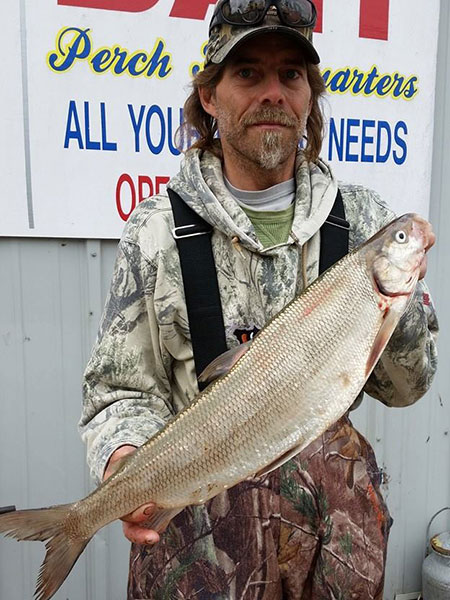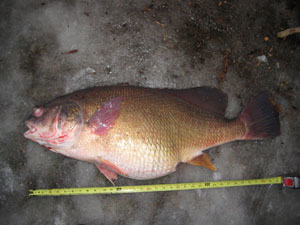- Details
(Provided by Michigan DNR)
The Michigan DNR recently released data from its 2014 state-licensed commercial fishing season. Combined, the state-licensed commercial fishery caught nearly 3,414,000 pounds of fish with an estimated wholesale dockside value of more than $5.8 million prior to processing, marketing and retail sales.
While the state's total harvest was about 200,000 pounds less than in 2013, the fisheryís estimated gross dockside value was up $300,000 (more than 5 percent). The increase in the fishery's value is almost exclusively attributed to a more-than-15-percent increase in the wholesale price of lake whitefish. This species' value has gone up more than 50 percent in the past two years.
"Lake whitefish is by far the most important commercial fish species in the Great Lakes, and a delicious option many consumers will find at their favorite local Michigan restaurant or retailer," said Tom Goniea, DNR commercial fisheries biologist. "The price of whitefish has been on the rise since 2010, but the increase in demand has accelerated in the past couple of years."
- Details
(Provided by Michigan DNR)
The Michigan DNR reminds anglers and retail minnow dealers of the baitfish regulations that need to be followed in Michigan. Although the requirement for state licensed bait retailers to provide customers with receipts upon purchasing live minnows no longer exists, all other regulations with respect to minnow use continue to be enforced.
Baitfish regulations were enacted in 2006 to reduce the potential for baitfish to move fish diseases as the state saw multiple fish die-offs in lakes Erie and Huron from viral hemorrhagic septicemia virus (VHSv).
“While fish kills from VHS have become less common, we do not want this fish pathogen to spread across Michigan,” said Tom Goniea, DNR fisheries biologist. “Our regulations are designed to prevent this from occurring.”
- Details
The Michigan DNR Commission finalized several regulations impacting the 2015-2016 fishing season at its†meeting on April 9.
Changes include a year-round Catch-and-immediate-release (CIR) fishing for bass statewide (unless otherwise closed to fishing). Please refer to the printed fishing guide for waters closed to fishing.
Other changes are:
- Lake Huron lake trout and splake regulations: MH-1 and MH-2 lake trout and splake regulations have changed from season of May 1 - Sept. 30 to Jan. 1 - Sept. 30 to align all of Lake Huron into one season.
- Lake Michigan lake trout regulations: MM-1, MM-2, MM-3 and MM-4 have changed to the following ñ minimum size limit shall be 15 inches and the maximum size limit shall be 27 inches, except the daily possession limit shall not include more than one (1) lake trout at 34 inches or greater. In MM-5, MM-6, MM-7 and MM-8 the minimum size limit has been changed to 15 inches. In MM-1, MM-2, MM-3, MM-4 and MM-5, the lake trout daily possession limit has been reduced from three (3) to two (2).
- Inland Trout and Salmon Regulations: Regulations affecting brook trout minimum size limits have changed, and there is a new regulation creating the Upper Peninsula's Brook Trout Restoration Areas.
- New hook restrictions: Changes are now in place to protect against salmon snagging in some waters.
Due to the Natural Resources Commission's temporary loss of regulatory authority, several regulations were not determined in time for the start of the 2015-2016 angling year (April 1) and consequently were not printed in the hard-copy version of the Michigan Fishing Guide. However, there are several areas of the guide that have an orange star to indicate that changes possibly would be forthcoming.
To view all of the change details, click here.
- Details
(Provided by Indiana DNR)
 Dan Rostecki with record whitefish (photo by Mary Beck Ryba)Dan Rostecki didn’t catch what he was after while fishing from the Michigan City pier last Saturday, but he did haul in a state-record lake whitefish instead.
Dan Rostecki with record whitefish (photo by Mary Beck Ryba)Dan Rostecki didn’t catch what he was after while fishing from the Michigan City pier last Saturday, but he did haul in a state-record lake whitefish instead.
“I was out there brown trout fishing on the bottom and thought I had one,” Rostecki said. “It ended up being a whitefish. It’s the first one I’ve ever caught. It was really, really a bonus.”
A record bonus no less.
DNR State Record Fish Program coordinator Jamie Smyth certified the record catch on Monday. Rostecki will receive a certificate and patch from the DNR Division of Fish & Wildlife as recognition of the record.
- Details
(Provided by Michigan DNR)
 Record drum caught from Gun Lake (Michigan DNR photo)The Michigan DNR confirmed a new state record last month for freshwater drum. This record marks the first one caught in 2015.
Record drum caught from Gun Lake (Michigan DNR photo)The Michigan DNR confirmed a new state record last month for freshwater drum. This record marks the first one caught in 2015.
A fish caught by Mark Leep of Middleville, Mich., on Gun Lake in Barry County Saturday, Jan. 24, at 4:30 p.m. beat the state record for freshwater drum. Leep was spearing. The fish weighed 28.61 pounds and measured 34.02 inches.
Kregg Smith, a DNR fisheries biologist in Plainwell, verified the record.


